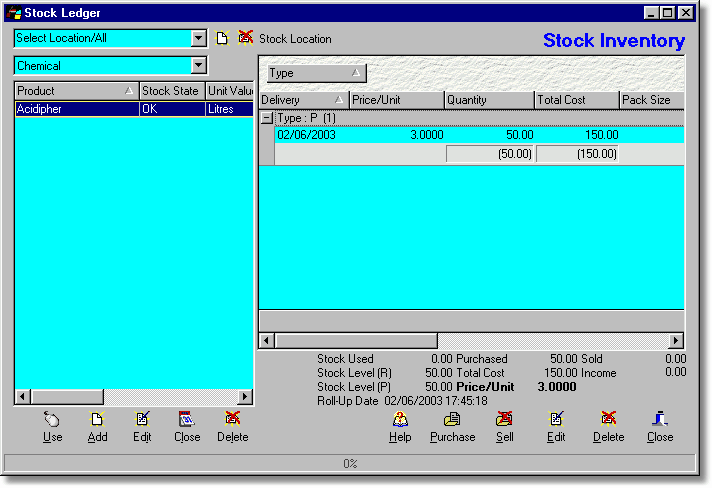
The stock inventory is where you create stock 'items' and also enter in purchases and sales to create stock item usage prices.
Stock Item List
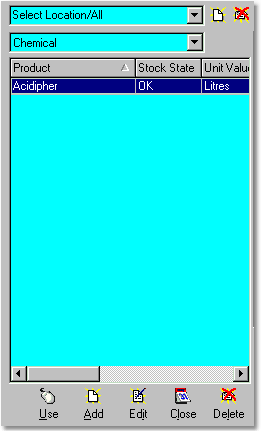
The stock item list can be narrowed down by stock location (store locations) and product types. You can customise the display grid and print out the stock items list by right-clicking on the list.
The "Stock Item" list can also be grouped using the right-click "Toggle Grouping" option on the list. As with the "Stock Inventory" list, Field Track will indicate the number of items in any particular grouping you may have. You can force a "Stock Item" to double check its figures by right-clicking on the stock list and selecting "Check Stock Figures".
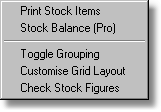
Stock Balance (Pro)
Stock records can be balanced manually, or through the use of a PDA device:
Stock State
To speed up Field Track's data processing, whenever you apply a product, Field Track does not update a stock item's stock level, or usage figure. Instead it 'tags' the item as "UPDATE" instead of "OK". Whenever you click on a stock item with an "UPDATE" status, Field Track will interrogate your database(s) and correct the figures and give it a status of "OK". It is important to realise that a status of "UPDATE" means that Field Track considers the stock item's information incorrect. This will probably only relate to the stock item's stock levels and usage figures.
Use
Use the currently selected stock item in the proceeding screen. This will generally mean 'add' the stock link to the product in the proceeding screen if you entered your stock inventory system from within the product database.
Add
Add a new stock item. The add requester will offer product names for stock items, however an item's name is up to the user. If you use more than one stock location it might be useful to give stock items a name which helps relate it to a location.
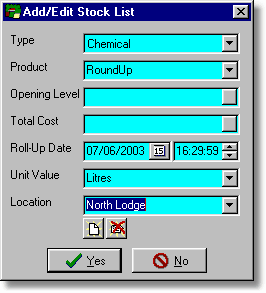
Type
This will be set for you, however if you entered a stock item under the wrong cost type, you can correct this here.
Opening Level
This is the opening stock level of the stock item. When creating a new stock item an opening level and cost is not required, as these entries are used more when you close a stock item for the season and any remaining levels are rolled forward for you. Normally a new stock item will have levels and prices created when add your first purchase. If an opening level is entered a total cost will also need entering.
Total Cost
This is the total cost of your opening stock level. The price/unit will use these two figures, etc. If you enter a total cost an opening level will also be required.
Roll-Up Date (Close Date)
The "Roll-Up" date and time is used by Field Track to only alter application records after this date and time. For example you may not want your new inventory costing's to affect an application last year. It is important that stock items are closed each year, as this will speed up Field Track when processing new costing's. Each stock item can only be 'closed' individually, so it is deemed you close a stock item before you enter in your first inventory item for the new year. There is currently no simple way to batch close stock items, however an upgrade may make this possible.
A common error people make is creating a stock item, which will default to the computer's date and time and forget that an application may have a start date and time before the stock item's "Close Date", thus stock levels do not alter to account for the application. The stock item's "Close Date" needs to be BEFORE the application's date and time for it to register in your stock control system levels.
The "Close" procedure will place any remaining stock into a new opening level and cost for you.
|
|
Edit the currently selected stock item.
Delete
Delete the current stock item and all inventory records.
Stock Inventory List
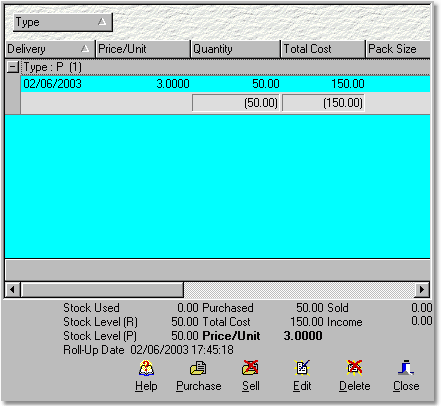
Each stock item gets its information from processing your stock inventory list of purchases and sales.
You can print this list by right-clicking the list, or pressing Crtl-P on the keyboard.
Stock Used
Amount of stock used on applications after the "Roll-Up/Close" date.
Stock Level (R)
Stock level as purchased or sold.
Stock Level (P)
Stock level of items that include a price. This stock level is used to calculate the stock item's price. Purchase ordered items are not included in these figures regardless of price.
Roll-Up/Close Date
The "Roll-Up" date and time used when altering field application records.
Purchased
Amount of stock purchased excluding sales and/or purchase orders.
Total Cost
Total cost of purchases excluding purchase orders.
Price/Unit
Stock item's current price based on purchases and sales.
Sold
Amount of stock sold out of the inventory list.
Income
Total income from inventory sales.
Purchase
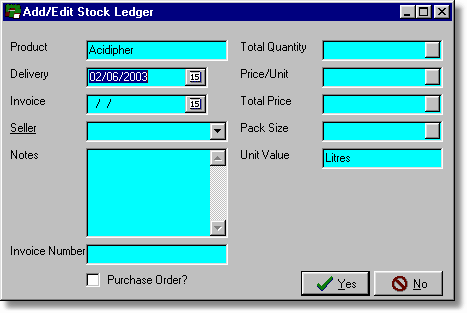
Enter new stock purchases against this stock item.
"Purchase Order" allows you to enter in stock with a price but not have it actually used in the calculation of the stock item price used on application records. The same effect can be attained by simply not entering in a price at all.
Sell
Sell stock inventory items.
Edit
Edit current stock inventory entry.
Delete
Delete currently selected stock inventory entry.
Close
Close stock inventory window.